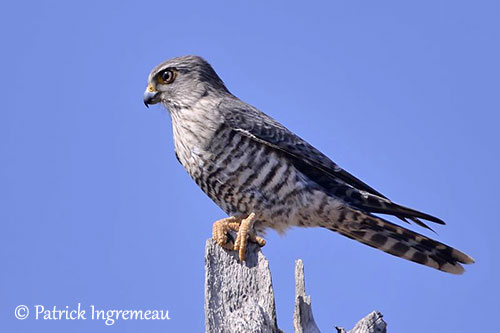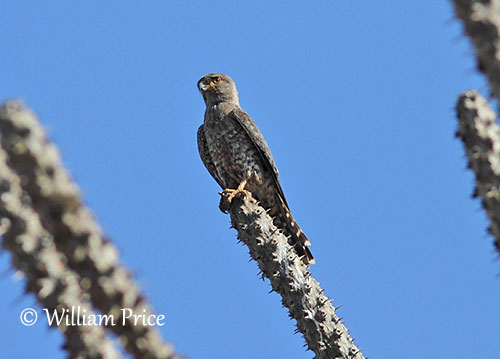
Banded Kestrel
Falco zoniventris
Falconiformes Order – Falconidae Family
INTRODUCTION:
The Banded Kestrel is endemic to Madagascar where it occurs from sea-level up to 2000 metres of elevation. It frequents clearings and forest edges, and favours the southern spiny forest. It hunts from perch and from the ground, and typically feeds on large insects, lizards and small birds.
The Banded Kestrel has currently stable population and is not globally threatened.

Fr : Faucon à ventre rayé
Ang : Banded Kestrel
All : Bindenfalke
Esp : Cernícalo Malgache
Ita : Gheppio fasciato
Nd : Gebandeerde Torenvalk
Sd : bandad falk
Malgache : akanga, Hitsik'ala, Hitsikitsik'ala
Photographers:
Patrick Ingremeau
TAMANDUA
William Price
PBase-tereksandpiper & Flickr William Price
Dubi Shapiro
Dubi Shapiro Photo Galleries & Dubi Shapiro's Pictures on IBC
Alan & Ann Tate
AA Bird Photography
Text by Nicole Bouglouan
Sources :
HANDBOOK OF THE BIRDS OF THE WORLD Vol 2 by Josep del Hoyo-Andrew Elliot-Jordi Sargatal - Lynx Edicions - ISBN: 8487334156
BIRDS OF PREY OF AFRICA AND ITS ISLANDS by Alan and Meg Kemp - Struik Publishers - ISBN: 1770073698
Global Raptor Information Network - Working to Conserve Birds of Prey in nature
Wikipedia, the free encyclopaedia
Breeding biology and diet of Banded Kestrels Falco zoniventris on Masoala Peninsula, Madagascar
Birds of Madagascar and the Indian Ocean Islands Par Roger Safford, Adrian Skerrett, Frank Hawkins
DESCRIPTION OF THE BIRD:
Biometrics:
Length: 25-29 cm
Wingspan: 60-68 cm
Weight: 180-240 g
The Banded Kestrel is a stocky, large-headed, heavy-billed falcon. It has dark grey-brown upperparts. On the upperwing, wing-coverts and scapulars show broad, pale grey barring. Flight feathers and rectrices are sooty-brown. The flight feathers are narrowly barred white on inner webs, whereas on the tail, only the outer rectrices are barred white. The rump feathers are narrowly tipped white.
On the white underparts, throat and cheeks are finely streaked dark. Rest of underparts shows broad, dark grey-brown bars. The underwing is barred grey and white. The wing tips are grey. The undertail is barred blackish and white.
On the grey-brown head, the forehead is paler and we can see a fine, dark moustachial stripe.
The bill is black with yellow cere, base and lower mandible. The eyes are pale yellow, surrounded by yellow eyering. The bare legs and the stocky feet are yellow with black talons.
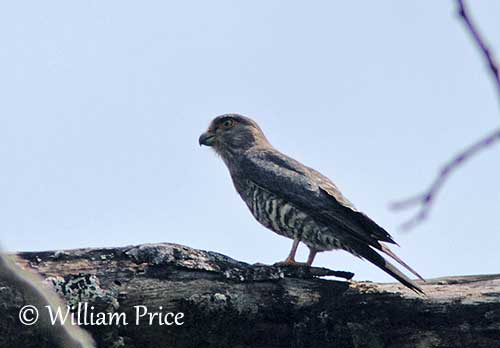
CALLS AND SONGS: SOUNDS BY XENO-CANTO
The Banded Kestrel occasionally gives shrill chatter, typical of other kestrels. The call is a harsh, rapid “kek kek kek” usually given in flight over the territory.
BEHAVIOUR IN THE WILD:
The Banded Kestrel feeds primarily on large insects such as Orthopterans, Coleopterans, flying ants, termites and mantises. It also catches small reptiles including chameleons, lizards and geckos, rarely snakes. It may catch small birds in flight after aerial pursuit.
It hunts from perch, searching for prey on the ground, in trees, branches and foliage. The prey is snatched in fast flight during which the raptor makes abrupt changes of direction. It moves from perch to perch with fast, direct flight.
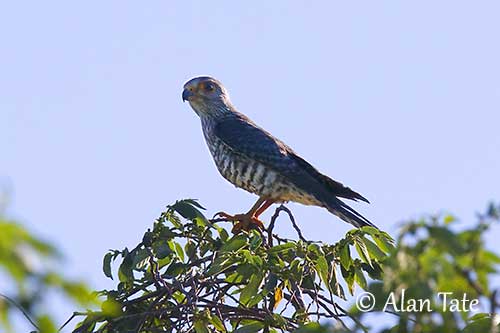
The female lays 3 creamy to dirty white eggs with brown spots. She incubates alone during 28-30 days, but she is regularly fed by the male during this period. The chicks are brooded and fed by the female with the prey brought at nest by the male. After one week, the female begins to hunt and feed the chicks. At three weeks old, the young are able to feed themselves and the adults leave the food at the nest. They fledge 26-30 days after hatching. They remain near the nest until 40 days of age, and they are still fed by their parents, usually on branches. They are independent at 55-56 days old.
PROTECTION / THREATS / STATUS:
The Banded Kestrel is locally common to uncommon, but the habitat is continuously degraded by deforestation.
The population is estimated to number 670/6,700 mature individuals (about 1,000 pairs) and is suspected to be stable.
This species is present in several protected areas, reserves and natural parks.
The Banded Kestrel is currently evaluated as Least Concern.
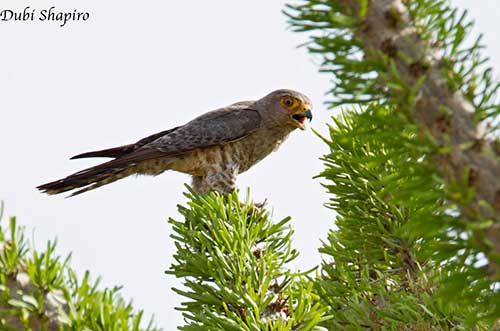
The courtship displays of this species are poorly known, but it probably performs some aerial displays accompanied by the calls of both mates. The black-and-white pattern of the underparts may be enhanced by some aerobatics. Courtship feeding is reported during the courtship period.
Like most Falconidae, the Banded Kestrel nests in natural cavities or sometimes uses abandoned stick nests.
The Banded Kestrel is sedentary within its restricted range, with only some seasonal movements in the East during the rainy season.
The flight is fast and direct with fast, shallow wingbeats between perches and while hunting. But it also performs gliding and soaring.
REPRODUCTION OF THIS SPECIES:
The nesting period has been documented from September to December.
The Banded Kestrel nests often in tree cavities, usually at base or inside a cluster of epiphytes, about 18 metres above the ground. It may sometimes use abandoned stick nests of Corvidae and Hamerkop.
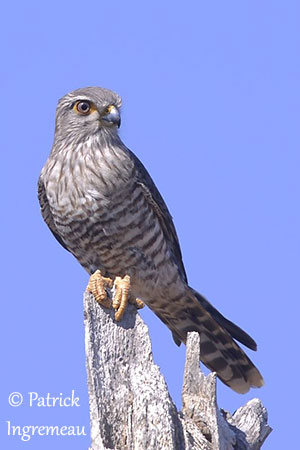
Male and female are similar. There are individual variations in tone of grey-brown and contrasts of markings.
The juvenile is browner than adults. The upperwing coverts and the feathers of both back and rump are finely tipped brown. Flight feathers and rectrices are barred pale rufous. The eyes are dark brown.
The fledging young has brown eyes and dull, blue-grey facial skin.
RANGE:
The Banded Kestrel is found throughout Madagascar, except on the central plateau.
HABITAT:
The Banded Kestrel frequents rainforest edges, forest clairing, secondary growth and dry woodlands, from sea-level up to 2000 metres of elevation. It favours the southern spiny forest where it can be seen perched at top of dead stub.
